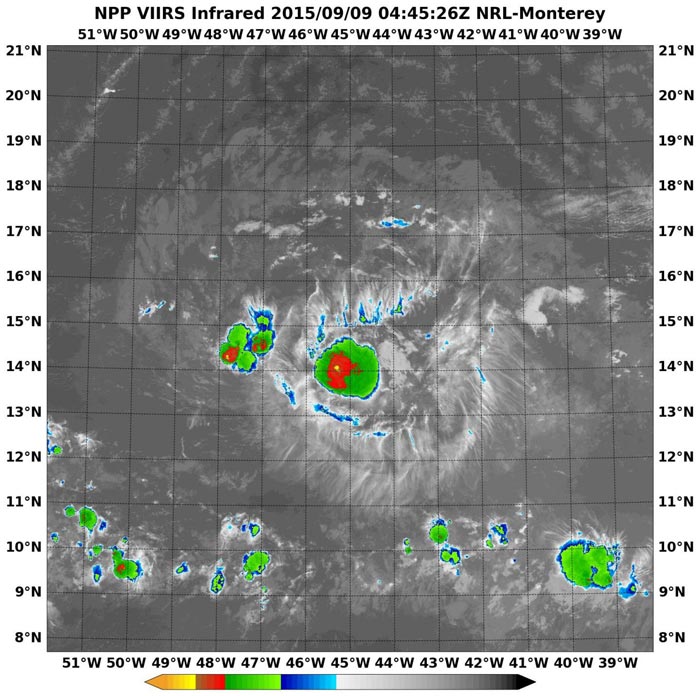NASA sees former tropical storm bow out 'Grace-fully'

NASA-NOAA's Suomi satellite flew over Grace at 4:45 UTC (12:45 a.m. EDT) on Sept. 9 and the VIIRS instrument aboard captured this infrared image. Satellite data showed Grace no longer had a closed circulation. Credits: NRL/NASA/NOAA
NASA-NOAA's Suomi satellite flew over Grace at 4:45 UTC (12:45 a.m. EDT) on Sept. 9 and the VIIRS instrument aboard captured an infrared image of the storm. Satellite data showed Grace no longer had a closed circulation and is now an open wave.
At 11 a.m. EDT (1500 UTC), on September 9, the remnants of Grace were located near latitude 14.5 North and longitude 49.0 West. That puts Grace's remnants about 825 miles (1,325 km) east of the Lesser Antilles.
The remnants were moving toward the west near 18 mph (30 kph) and this general motion is expected to continue over the next couple of days. Maximum sustained winds were near 30 mph (45 kph) with higher gusts. The National Hurricane Center said that “little change in strength is expected over the next day or two.” The estimated minimum central pressure is 1008 millibars.
NHC Forecaster Pasch noted that “Data from the Rapidscat instrument onboard the International Space Station showed that there were no longer any westerly surface winds in Grace. This was confirmed by animation of high-resolution visible imagery that showed no westerly low-cloud motions.” Since Grace had opened up into a wave, the National Hurricane Center issued its final advisory.
Grace's remnant wave is expected to continue moving quickly to the west. NHC noted that the remnants could produce some gusty winds and showers over portions of the Lesser Antilles within a couple of days.
Media Contact
All latest news from the category: Earth Sciences
Earth Sciences (also referred to as Geosciences), which deals with basic issues surrounding our planet, plays a vital role in the area of energy and raw materials supply.
Earth Sciences comprises subjects such as geology, geography, geological informatics, paleontology, mineralogy, petrography, crystallography, geophysics, geodesy, glaciology, cartography, photogrammetry, meteorology and seismology, early-warning systems, earthquake research and polar research.
Newest articles

High-energy-density aqueous battery based on halogen multi-electron transfer
Traditional non-aqueous lithium-ion batteries have a high energy density, but their safety is compromised due to the flammable organic electrolytes they utilize. Aqueous batteries use water as the solvent for…

First-ever combined heart pump and pig kidney transplant
…gives new hope to patient with terminal illness. Surgeons at NYU Langone Health performed the first-ever combined mechanical heart pump and gene-edited pig kidney transplant surgery in a 54-year-old woman…

Biophysics: Testing how well biomarkers work
LMU researchers have developed a method to determine how reliably target proteins can be labeled using super-resolution fluorescence microscopy. Modern microscopy techniques make it possible to examine the inner workings…





















